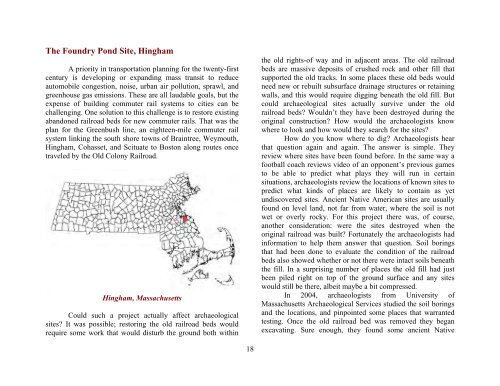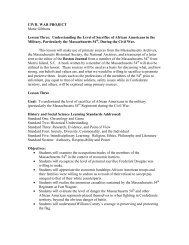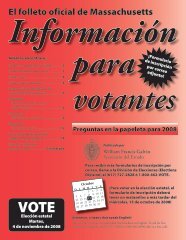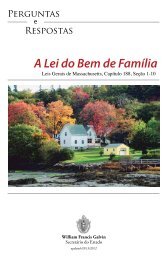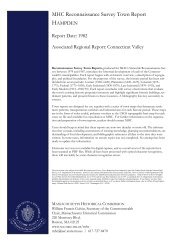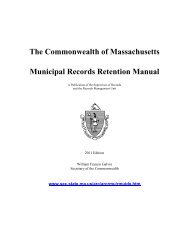Roads, Rails, and Trails - Secretary of the Commonwealth
Roads, Rails, and Trails - Secretary of the Commonwealth
Roads, Rails, and Trails - Secretary of the Commonwealth
You also want an ePaper? Increase the reach of your titles
YUMPU automatically turns print PDFs into web optimized ePapers that Google loves.
The Foundry Pond Site, Hingham<br />
A priority in transportation planning for <strong>the</strong> twenty-first<br />
century is developing or exp<strong>and</strong>ing mass transit to reduce<br />
automobile congestion, noise, urban air pollution, sprawl, <strong>and</strong><br />
greenhouse gas emissions. These are all laudable goals, but <strong>the</strong><br />
expense <strong>of</strong> building commuter rail systems to cities can be<br />
challenging. One solution to this challenge is to restore existing<br />
ab<strong>and</strong>oned railroad beds for new commuter rails. That was <strong>the</strong><br />
plan for <strong>the</strong> Greenbush line, an eighteen-mile commuter rail<br />
system linking <strong>the</strong> south shore towns <strong>of</strong> Braintree, Weymouth,<br />
Hingham, Cohasset, <strong>and</strong> Scituate to Boston along routes once<br />
traveled by <strong>the</strong> Old Colony Railroad.<br />
Hingham, Massachusetts<br />
Could such a project actually affect archaeological<br />
sites? It was possible; restoring <strong>the</strong> old railroad beds would<br />
require some work that would disturb <strong>the</strong> ground both within<br />
18<br />
<strong>the</strong> old rights-<strong>of</strong> way <strong>and</strong> in adjacent areas. The old railroad<br />
beds are massive deposits <strong>of</strong> crushed rock <strong>and</strong> o<strong>the</strong>r fill that<br />
supported <strong>the</strong> old tracks. In some places <strong>the</strong>se old beds would<br />
need new or rebuilt subsurface drainage structures or retaining<br />
walls, <strong>and</strong> this would require digging beneath <strong>the</strong> old fill. But<br />
could archaeological sites actually survive under <strong>the</strong> old<br />
railroad beds? Wouldn’t <strong>the</strong>y have been destroyed during <strong>the</strong><br />
original construction? How would <strong>the</strong> archaeologists know<br />
where to look <strong>and</strong> how would <strong>the</strong>y search for <strong>the</strong> sites?<br />
How do you know where to dig? Archaeologists hear<br />
that question again <strong>and</strong> again. The answer is simple. They<br />
review where sites have been found before. In <strong>the</strong> same way a<br />
football coach reviews video <strong>of</strong> an opponent’s previous games<br />
to be able to predict what plays <strong>the</strong>y will run in certain<br />
situations, archaeologists review <strong>the</strong> locations <strong>of</strong> known sites to<br />
predict what kinds <strong>of</strong> places are likely to contain as yet<br />
undiscovered sites. Ancient Native American sites are usually<br />
found on level l<strong>and</strong>, not far from water, where <strong>the</strong> soil is not<br />
wet or overly rocky. For this project <strong>the</strong>re was, <strong>of</strong> course,<br />
ano<strong>the</strong>r consideration: were <strong>the</strong> sites destroyed when <strong>the</strong><br />
original railroad was built? Fortunately <strong>the</strong> archaeologists had<br />
information to help <strong>the</strong>m answer that question. Soil borings<br />
that had been done to evaluate <strong>the</strong> condition <strong>of</strong> <strong>the</strong> railroad<br />
beds also showed whe<strong>the</strong>r or not <strong>the</strong>re were intact soils beneath<br />
<strong>the</strong> fill. In a surprising number <strong>of</strong> places <strong>the</strong> old fill had just<br />
been piled right on top <strong>of</strong> <strong>the</strong> ground surface <strong>and</strong> any sites<br />
would still be <strong>the</strong>re, albeit maybe a bit compressed.<br />
In 2004, archaeologists from University <strong>of</strong><br />
Massachusetts Archaeological Services studied <strong>the</strong> soil borings<br />
<strong>and</strong> <strong>the</strong> locations, <strong>and</strong> pinpointed some places that warranted<br />
testing. Once <strong>the</strong> old railroad bed was removed <strong>the</strong>y began<br />
excavating. Sure enough, <strong>the</strong>y found some ancient Native


